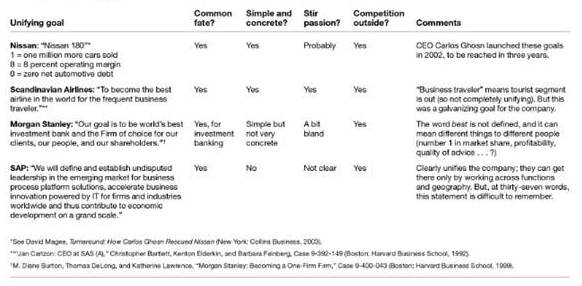Yet another ‘Book By Quote’ then (An attempt to subjectively summarise a book by the quotes I found worthwhile to mark, to remember. Be aware that the quotes as such, aren’t a real unbiased ‘objective’ summary; most often I heartily advise to read the book yourself..!)
So, this time: Morten T. Hansen, Collaboration, Harvard Business Press, 2009, ISBN 9781422115152.
Yet the goal of collaboration is not collaboration, but better results. (p.15)
Leaders who pursue disciplined collaboration never lose sight of this dictum: collaboration is a means to an end, and that end is great performance. (p.16)
… the disciplined collaboration framework targets four barriers: (pp.16-17)
- The not-invented-here barrier (people are unwilling to reach out to others)
- The hoarding barrier (people are unwilling to provide help)
- The search barrier (people are not able to find what they are looking for)
- The transfer barrier (people are not able to work with people they don’t know well)
In tailoring their solutions, leaders can choose a mix of three levers. … unification lever … people lever … network lever. (pp.17-18)
The idea of disciplined collaboration is to let organization units work independently when that approach produces the best results … This approach, however, needs to be complemented — not replaced – with a “behavioural overlay” of collaborative efforts, … (pp. 18-19)
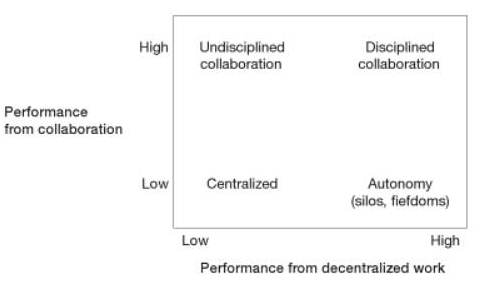
[Disciplined collaboration: High performance from decentralization and collaboration]
The first task is to understand the case for collaboration – to appreciate how collaboration can increase performance.
The second task is to evaluate the upside for the company – to consider the potential for the organization overall.
The final task is to understand when to say no to a collaboration project – to articulate a decision rule for when to go ahead, and when not to, at the project level. (p.26)
There are three areas of potential upside in business: better innovation, better sales, and better operations. In a nonbusiness context, these can be thought of as new services, greater client satisfaction, and better-run organizations. (p.26)

[How collaboration can add up to substantial fiancial performance; the three areas of collaboration – innovation, sales, operations – improve sales growth, cost savings, and asset efficiency, leadin to better return on equity]
Collaboration premium = return on project – opportunity costs – collaboration costs (p.41)
They did not believe that others could teach them useful practices, in part because they viewed their problems as unique. But they were not. (p.51)
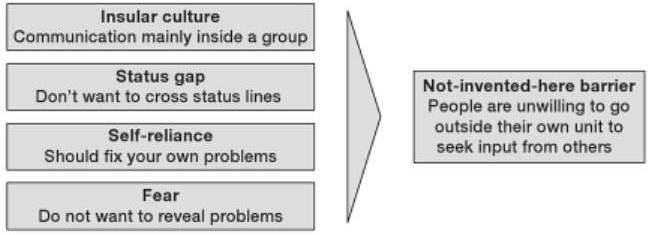
[The first barrier: Why not-invented-here happens]
For members of low-status groups, reaching out to high-status groups ruins the comfort of being with people of the same status. … But mingling with high-status people destroys this reassurance and reminds them of their fate. (p.52)

[The second barrier: Why people hoard]
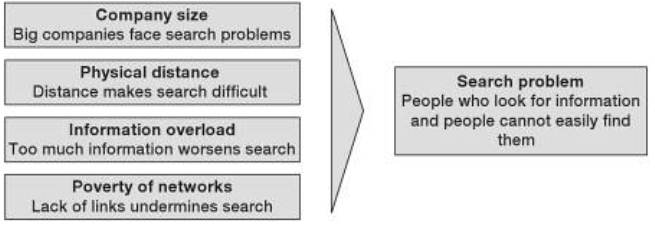
[The third barrier: Why search is difficult]
It may be a small world for a few well-connected people, but it’s a big world for many others, and that’s a formidable barrier to search. (p.60)

[The fourth barrier: Why transfer problems happen]
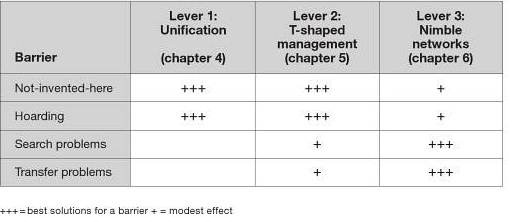
[The barrier-to-solution map; pick a barrier a then read across to see which solutions fit best]
Three fundamental unification mechanisms allow a leader to translate the lofty aspiration of unity into concrete measures: (1) creating a unifying goal, (2) inciting a commoon value of teamwork, and (3) speaking the language of collaboration. (p.74)
But, there is a problem with simplicity. Most leaders, when they try to be simple, turn out vague and abstract goals, not concrete ones. (p.80)
Competition should be directed to the outside. Collaboration on the inside, competition on the outside. (p.82)
But as they preach teamwork, they need to beware of three sins.
Sin Number 1: Small Teamwork Kills Collaboration
Sin Number 2: Everybody Do Teamwork Now (Except Those of Us at the Top)
Sin Number 3: Teamwork Becomes the Point of It All (pp.84-86)
The language a leader chooses matters a great deal in shaping behaviour. … the language of management has a sneaky tendency: it becomes true even if it isn’t true at the outset. (p.88)
But there is a dark side to all this. Unification runs the risk of absolving the individual of responsibility. People can hide behind a unifying goal. They can participate in teams without pulling their weight. And they can interpret all the talk about collaboration as an excuse not to do their share. (p.89)
Table 4-3: Putting discipline into collaboration / To practice disciplined collaboration, leaders need to balance unification with individual accountability: (p.90)
| Unification | Balanced with individual accountability | |
| Goals | Unifying goal | Individual goals |
| Values | Teamwork | Individual responsibility |
| Language | Language of collaboration | Language of accountability |
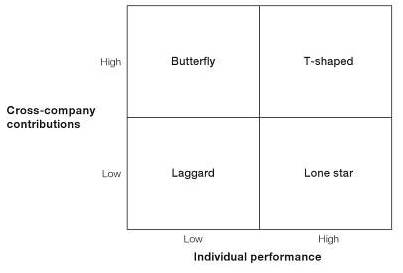
[Cultivate T-shaped management]
The idea of cultivating T-shaped management puts the whole business of “the war for talent” in a new light. The idea is not to attract or develop anyone who is a star. It’s a misplaced focus. The war for talent should not be about stars of all kinds but about T-shaped stars. (p.97)
Table 5-1: Two ways to enlarge the pool of T-shaped managers (p.100)
| Select people | Get people to change | |
| Belief | People don’t easily change, if at all, so let’s pick those who already exhibit T-shaped behaviours | People can change to T-shaped behaviors if properly stimulated and helped. |
| Promotion (and firing) | Big effect: promote T-shaped, not others. Fire lone stars and butterflies. | Big effect: use T-shaped promotion criteria as a carrot for people to change their behaviors so that they are promoted. |
| Pay and bonuses | Small effect: pay more for T-shaped, hoping that some good people might be attracted to that. | Big effect: use T-shaped rewards criteria as a carrot for people to change their behaviors to get better rewards. |
| Hiring | Big effect: recruit T-shaped, not others. | Does not apply (hiring is about selecting, not changing, people). |
| Leadership coaching | Does not apply (coaching is about change, not selection). | Big effect: provide support to help people change their behaviors to T-shaped. |
Most people do not function this way. It is not that individual contributions – even if tiny – don’t matter; many small do make one large. The problem is that each employee must believe that other employees will also make an effort: if employees don’t believe this, they won’t make their own small effort, because they assume that their effort alone is insignificant. Second, it assumes that employees won’t engage in what is called free-riding. (p.106)
All too often, executives go back to work trying to change thier behaviors, but nothing has changed around them! (p.109)
… is a bridge – someone who, by virtue of his network, can connect tha many islands of a company by putting people in contact with each other. (p.119)
And yet networks – or wrong ideas about them – often get in the way of disciplined collaboration. (p.119)
They didn’t need these interactions, because their own experience was sufficient, but maintaining and using these relations represented a distraction from … (p.120)
With all due respect for Gladwell, such beliefs are misplaced. Research shows that “the more, the merrier” does not necessarily yield the best results, at least not when it comes to networking in business. (p.120)
Research shows that personal traits related to being socially gifted, such as being extroverts, do not determine whether people are effective networkers. (p.122)
The final myth is that networking is an art, not a science. (p.122)
“What are networks good for?” research shows that networks provide two fundamental benefits. … help people identify opportunities; people use existing professional relationships to find resources. … networks help people capture value; people realize benefits from the resources they have identified. (pp. 122-123)
Networks reduce all four barriers outlined in chapter 3, although to different degrees:
- The not-invented-here barrier: identifying opportunities requires that people be willing to look for them. If they spend most of thier time talking to colleagues within their own units, they will not discover many opportunities elsewhere. Networks can help reduce this reluctance somewhat, because people who interact with others tend to be more open to input from the outside world.
- The search barrier: Once people are willing to look for opportunities outside their own units, they need to be able to search efficiently. Networks an have a huge impact by helping people search better.
- The hoarding barrier: Networks can help people overcome the hoarding barrier somewhat, because people are more willing to help those whom they know.
- The transfer barrier: Good networks can lower transfer problems. Good relationships among colleagues help overcome the difficulty of passing along complicated knowledge people need to do their work. (p.123)
Six network rules help people identify opportunities and capture value: (p.124)
| Key activity | Barrier lowered | Network rule | Effect |
| Identify opportunities | Not-invented-here | Rule 1: Build outward, not inward | + |
| Search | Rule 2: Build diversity, not size | +++ | |
| Rule 3: Build bridges, don’t use familiar faces | |||
| Rule 4: Build weak ties, not strong | |||
| Capture value | Hoarding | Rule 5: Swarm target, don’t go it alone | + |
| Transfer | Rule 6: Switch to strong, don’t rely on the weak | +++ |
Research shows that it is not size – the sheer number of contacts maintained by a person – that counts. Rather, it’s the diversity of connections – the number of different types of people, units, expertise, technologies, and viewpoints – that people can access through their networks. (p.127)
When managers build network diversity, they first need to decide which factors matter. (p.128)
Bridges are uniquely placed by virtue of thier networks to help other people search. They direct queries. Peopl use them for whom they know, not for what they know. (p.130)
To spot bridges, look for long-tenured people who have worked in different places in the company and who know about a broad range of topics. (p.131)
Mentioning the names of common contacts is the lightest swarming tactic. A more forceful one is to get common contacts to work on your behalf… (p.133)
When working across the company, people can also influence others by appealing to the common good (“We’re working for the same company”) and invoking reciprocity (“If you help me, I will help you”). (p.134)
Molotov cocktail = weak ties x complicated knowledge
Easier transfer = strong ties x complicated knowledge (p.135)
| Nimble network = | identify opportunities | x capture value |
| Built outward | Swarming targets | |
| Diverse | Switching to strong ties | |
| Many weak ties | ||
| Many bridges |
(p.137)
Table 6-5: How the rules apply to individual and company networks (p.138)
| Principle | Individual network (connections to colleagues in other units) | Company network (connections across all units) |
| 1. Build outward |
Build relations to other units. Metric: percent of all your ties that are people outside your own unit |
Connect pairs of units. Metric: number of pairs of units well connected |
| 2. Build diversity |
Build ties to different types. Metric: number of different ideas,skills, tehcnologies, expertise, offices, etc. that you get through your network |
Connect units that are different. Metric: number of different types of units, ideas, skills, expertise, etc. that are connected |
| 3. Build weak ties |
Build a good number of weak ties. Metric: percent of contacts in your network that are weak |
Encourage people to communicate occasionally (not always often). Metric: percent of cross-unit ties that are weak |
| 4. Use bridges |
Find the best bridges and use them for search. Metric: number of good bridges you know and use |
Cultivate many bridges everywhere. Metric: number of people in the company who are bridges |
| 5. Swarm the target |
When needed, enlist support of others to persuade the target. Metric: number of times you successfully swarmed the target |
Coach people to rely on informal persuation (swarming) across units. Metric: number of times people fail to get things done across units. |
| 6. Switch to strong ties |
When needed, invest in strong ties. Metric: number of times you invested up front in building realtionships in cross-unit teams |
Encourage up-front investments in strong ties. Metric: number of times cross-unit teams fail due to lack of strong ties. |
Table 7-1: The three behaviors of a collaborative leadership style: (p.148)
| Behavior | What it means |
| Redefining success: from narrow agendas to bigger goals | Collaborative leaders redefine success and focus on goals bigger than their own narrow agendas. They seek common ground, look for pragmatic solutions, and compromise. |
| Involving others: from autocratic to inclusive decision making | Collaborative leaders involve others in decision making and exhibit an open mind – to alternatives, divergent views, dialogues, and working with others. |
| Being accountable: from blaming to taking responsibility | Collaborative leaders hold themselves accountable, and they also demand accountability from others. |
Fundamentally, leaders who … practice inclusiveness have an open mind by following three practices: (pp.154-155)
- Openness to People
- Openness to Alternatives
- Openness to Debate
One risk of an inclusive approach to decision making is that leaders debate endlessly without forging decisions and moving ahead. To combat this risk, collaborative leaders also need to be decisive. (p.155)
These studies gave rise to what is called social loafing: people tend to contribute less in a group setting. (p.157)
The bystander effect and social loafing point to a vital problem in collective work: when people can hide, they often do. (p.157)
The antidote to this malaise is the third behavior found in collaborative leadership: a high degree of individual accountability. (p.157)
Table 7-3, how five personal barriers block a collaborative leadership style (p.160)
| Redefining success | Being inclusive | Being accountable | |
| Power hunger | Biggest negative | Negative | Small negative |
| Arrogance | Negative | Biggest negative | No effect |
| Defensiveness | Big negative | Big negative | Biggest negative |
| Fear | Small negative | Small negative | No effect |
| Ego | Small negative | Small negative | No effect |
Why am I doing this, when this goes around ..?


